|
|
|
|

|
|
|
|

We must let go of the life we have planned to accept the one that is waiting for us. –Joseph Campbell
I need another, smaller surgery. I’ve had intense sciatic pain for a few months (part of the reason why I haven’t been writing). I’m so grateful to be under close watch because the doctors found the culprit: a small blip on my lower spine (L5/S1) which they think dripped down from the original tumor. I’ve had the maximum amount of radiation in that area, so surgery is our next best step.
It’s gardening season, people! It’s time to weed out what no longer serves us. This little punk tumor is no longer serving me. What no longer serves you?
When? Wed. June 14th, at Rhode Island Hospital in Providence, RI. I’ve been told that this is a wonderful, nurturing date. And that it is Flag Day?!
Who? We’ve chosen Dr. Gokaslan, one of the leading experts in spinal tumors because Dr. Al-Mefty “only” specializes on the skull. Dr. Gokaslan is the same doctor who didn’t operate on me in 2019 because of a hairpin turn of events.
Recovery? Acute recovery period is about 3 weeks in RI. Then continued recovery at home for several months.
Here’s the approx. timeline:
June 14-21: 7 days in Rhode Island Hospital in Providence. Kurt will stay at an AirBnb nearby. Kids will stay home in Boulder, taking care of Leo, the dog.
June 21-28: I’m transferred to Newport Hospital Rehab Facility in Newport, Rhode Island for 7 days in the hospital to retrain my brain to use new nerves to walk well. Kurt returns to Boulder.
June 28: Ready to go home (fingers crossed) to continue to recover! (We know this is a good date because it is our friend Gideon’s birthday!) I may need to stick around back east until July 5 to be near my doctor.
To remember:
How to help:
Dr. Al-Mefty (my skull surgeon) once said, “Susie, you are a fighter. This is not the end, nor is it the beginning of the end. It is just another challenge, and you are good at those.”
My smart-a** self says, “Really, Universe? THIS is what I’m “good” at? But what makes me “good” at challenges is that I don’t feel alone. I’m so grateful; it’s not lost on me how privileged I am to have the care that I receive. And, I am grateful for YOU for being there with me every step of the way. We all have our own mountains to face, (and we all have a sore neck, knee or a**) but I firmly believe that together, we can do anything.
Love,
Susie
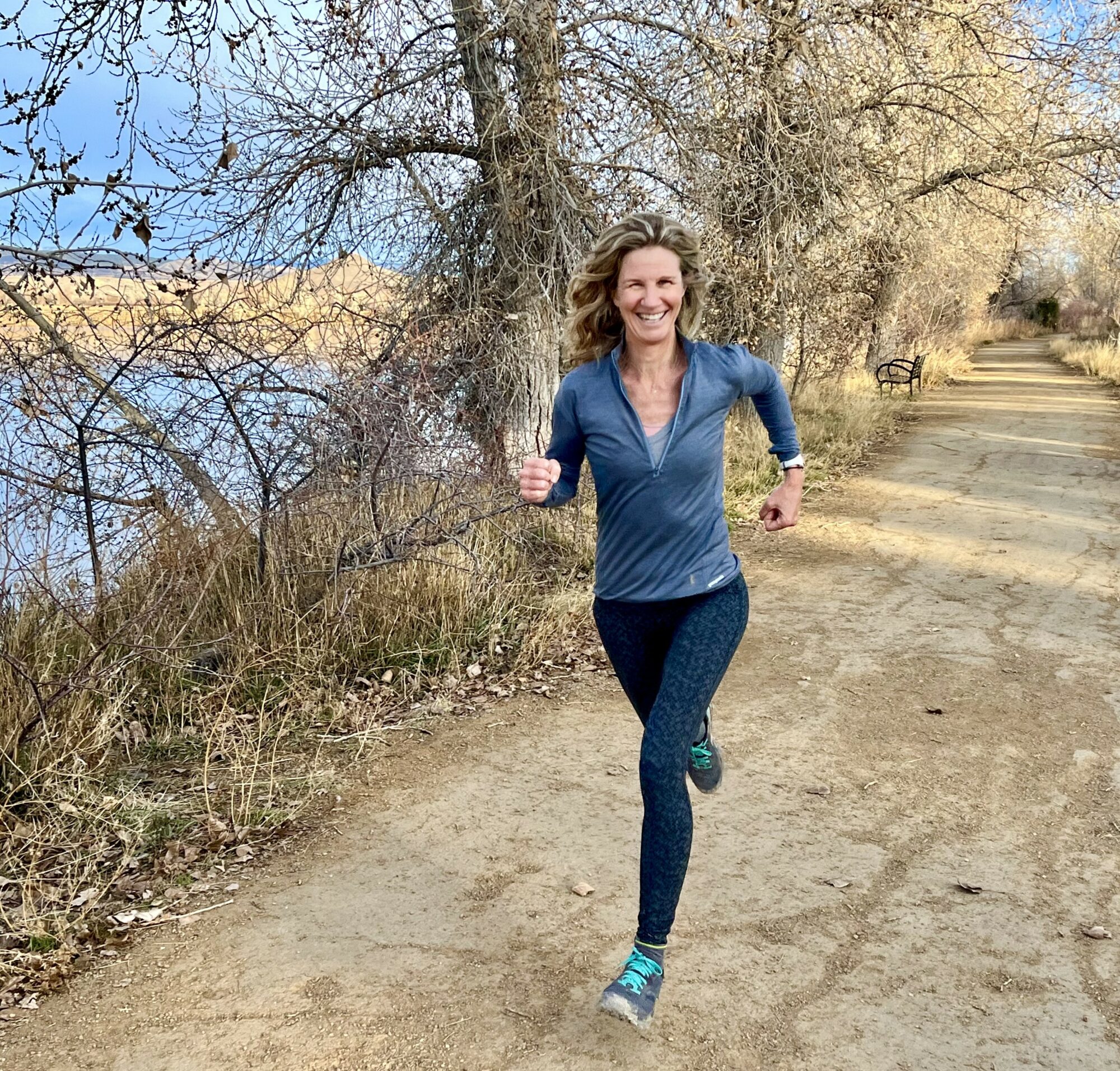
In ten days, I’m running the COLDER Bolder. Yes! I’m running again! Repeat the Sounding Joy! It’s been six years since I last ran. It feels amazing to run my favorite trails again, with dogs and friends, letting the dog off the leash, and letting my soul off leash, too.
My goal is to complete the 5K “race” on December 10th to raise funds for Chordoma Cancer research, for a BIG, new, important research project. (see below)
The road back to running has been tough and surprising. I learned a lesson that might help you with whatever pain or fears you are carrying right now. It is a lesson that writer Sarah Polley applied to overcome a debilitating concussion and past traumas in order to write her incredible collection of essays, Run Towards the Danger.
I laced up my running shoes as soon as X-rays showed that my neck, with all of its hardware, was stable and solid. I was thrilled to feel the wind in my hair again. I felt elated and vital.
But the minute I felt nerve pain in my neck and spine, I stopped. I lay in bed, awake at night, my mind lit up like a car dashboard with several “check engine” lights on. I was terrified that the pain I was feeling was not caused by muscle inflammation, but tumor growth. I was convinced that I was experiencing symptoms of tumor activity, not regular exercise ache on muscles that had not been in use in six years.
In the morning, I called my friend Lisa who is a phenomenal Physical Therapist. She examined me and emphasized all the important points about talking to my doctor and getting MRI scans. But she also knew I had clean scans two months before. She looked at me and said, “Your brain hasn’t learned that the threat you experienced six years ago is no longer a significant threat. Your tolerance for pain has dropped considerably. You need to increase your pain tolerance to re-train your brain, so that it doesn’t alarm every time you have minor pain.”
I need to increase my pain tolerance? That floored me. I proudly imagined myself as someone with a high pain tolerance. I didn’t realize that time, age, and a little pandemic can mess with our greatest superpowers.
My nervous system post-surgeries and post-pandemic is hypervigilant and overprotective. It’s like a helicopter parent who doesn’t know when to back off. It alarms when I do anything scary. Like run. Or socialize in big groups. Or write this blog. It wants to protect me from harm, but it’s narrowing my life.
“The fear of pain is likely worse than the pain itself.”–Dr. Adriaan Louw, PT, PhD
The good news is that we can raise our tolerance for discomfort. We need to re-train the brain to alarm only when necessary, giving us more space to move, breathe, write, run, and live!
Of course I know that I have to be careful. I am living with a chronic, terminal condition. But the side effect of being too careful is that I don’t live fully. Instead of backing off my running, I’ve kept going, while also getting scans every three months to make sure there is not a damaging physical threat. The key to success in growing my tolerance for pain is gradual exposure. I run 5k now, not 50k. And I started with 0.5k.
I also have a mindfulness routine each morning that is more like a coffee chat with my brain. I remind it of my clean scans. And I listen to all its fears, paranoias, and worst case scenarios. I feel each one in my body. Then I gently ask my brain to picture a calm, happy moment. It’s like an 11-minute pep rally for peace to begin my day.
As snow falls softly outside, I wonder, Are all of our nervous systems hypervigilant now? What do we need to do to be defiant and retrain our brains to stop alarming all the time?
How can we gradually increase our exposure to what scares us or has hurt us in the past, so that we don’t narrow our lives, but rather imagine that we have “grow(n) thin to a starting point” as Mary Oliver says?
And begin again to be brave.
Love,
Susie
P.S) I am running in the COLDER Boulder 5K on December 10th to raise funds for The Chordoma Foundation and a vitally important new research project that could open the door to brand new treatment options for me and others like me! My goal is to raise $2022 in 10 days. Can you pitch in $20 today? Canadians can make a tax-advantaged gift to this project here; U.S. individuals can do so here.
The work will be led by renowned researchers in my hometown of Toronto, Dr. Gelareh Zadeh, a neurosurgeon-scientist who has deep expertise in chordoma and Dr. Thomas Kislinger, a leading expert in cancer proteomics. Their goal is to discover proteins on the surface of chordoma cells that could serve as targets for emerging treatments — like systemic therapies that selectively target tumor cells, and various types of immunotherapy. Once they identify these markers, they can test if drugs developed for breast cancer, for example, could help chordoma patients, too. This would be a HUGE win!!
Thank you for considering pitching in to make this possible. If you have questions about this project or your contribution to it, reach out to Kenny ([email protected]) at the Chordoma Foundation.

My mom is visiting on her annual migration from Mexico to Toronto, by way of Colorado. She lives six months of the year outside Guadalajara, six months in Toronto. Many might think it’s dangerous to live alone, in Mexico, as a single woman in her eighties, but she brushes off their concerns. “People underestimate the people of Mexico. And me.”
To Mom, life is meant to be lived as an adventure, full of discovery and learning.
While I was growing up in Toronto, Mom held an Honors degree in Physical Education. She coached her Track and Field teams to record-breaking victories at the Ontario Provincial finals. (Her way of coaching me was to toss my running shoes outside, then me, and shut the door.)
When Mom was 49, she changed course. She went back to school to get her Masters in Art History. To others, it was an unexpected divergence, but it made sense to her. She loved sports and she also loved Art. Where was the contradiction? Again, life was meant to be lived as an adventure, and one immersed fully in learning and discovery.
When people questioned her decision to switch from what she knew to something new and different, Mom marveled at how people could ignore the gravitational pull of their curiosity. She’d say, “Doesn’t everybody look at a painting and wonder, Who came up with that idea? and What does it say about who we are as humans?” She often took us to the Art Gallery of Ontario in Toronto and had us notice the small details in giant paintings. How many tulips do you count in the bottom right? What else can you learn about it while looking? For Mom, studying Art was the next logical step in a life devoted to discovery.
Each spring, when she arrives at our home in Colorado, we make a new painting to hang on the front wall of our home. It’s kind of a funny thing to do to display Art outside the house, but it makes me happy. I am not a painter, but I love color and paint. Plus it feels good to do something for the sheer delight of it. We include Mom, her grandchildren, and many of the neighborhood kids in the making of the painting. The tradition started when I wanted to paint the whole house a different color and my husband did not. Until we could agree on what to do, he suggested I paint a giant canvas and hang it next to our front door.
Eventually, I let go of the idea of painting our brick house, but we continue to make fresh paintings for the wall out front every season. They are less like paintings and more like posters, with bold blocks of color and almost no shading. Shading takes skill and time, something we don’t have.
It’s raining outside so Mom, my daughter Hazel, and I work on the living room floor. The Brave over Perfect moment here is allowing the painting to be bad. We think of it as play, not product. We have to work fast before the dog walks across the fresh paint. As we paint, we talk. Hazel asks Mom, “What was it like being in your 20s during the 1960s?” Mom responds quickly, “If you remember the 60s, you weren’t there.” She can always make me laugh.
Minutes later, Mom wants to show Hazel a picture of Leonardo DaVinci’s “The Last Supper.” She accidentally types into Google, “DaVinci Last SUMMER.” Google understands what she means and offers up images of the famous painting, but it’s too late. The idea is too absurd. Mom takes hold of it and comes up with different scenarios for DaVinci’s last summer. “Can you imagine DaVinci on the beach, frail in a speedo, ordering his last fruity drink with an umbrella in it?” We get the giggles and can’t stop. We have to put our paintbrushes down.
I’m writing on the cusp of Mother’s day, thinking about the many gifts my mother has given me. Laughter, yes. A love of athletics, literature and Art, yes. But the gift I am most grateful for at the middle place in my life is Mom’s ability to follow her curiosity without concern.
It’s easy for me to be hard on myself when I take the time to paint instead of work or write, for example. I see it as a flaw, like I don’t have the metal it takes to pick one thing and go all the way with it.
My mother doesn’t ruminate or dwell; she prefers to lean toward what is delicious and delightful.
Today, I am choosing to look at life through Mom’s radiant lens. I am crawling around a canvas on the living room floor with my daughter and my mother, wondering what shade of pink to use for clouds at sunset. I want to capture this moment and frame it. I am keenly aware of how precious it is and fleeting. So while I am already on my knees, covered in paint, I bow down in gratitude for the gift of my Mom.
Happy Mother’s Day!!
Love,
Susie
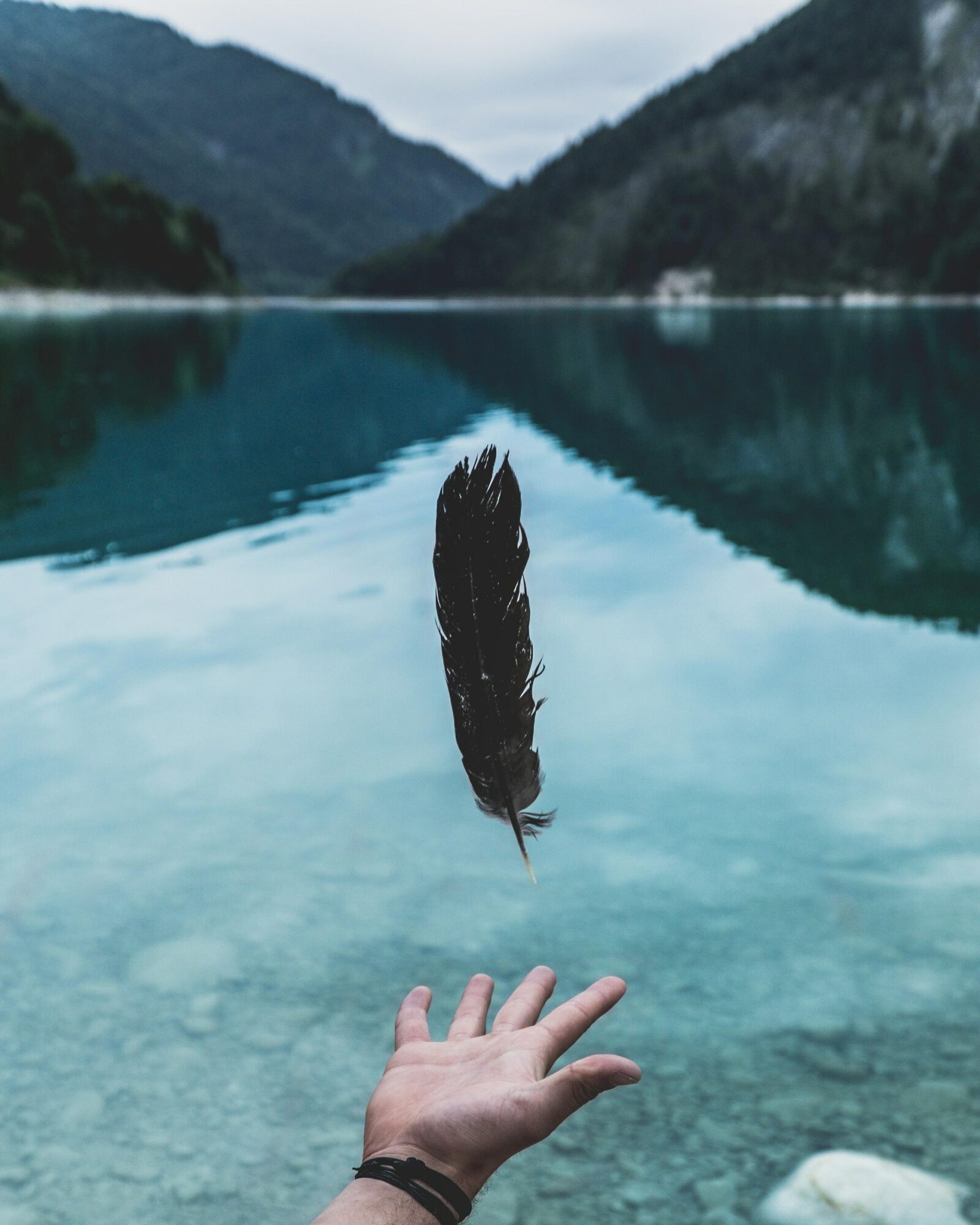
I’m playing with the idea of let loose instead of let go. Here’s what I mean. To let go completely is too much pressure. But to let loose is bite-sized, doable, a step forward in the right direction. I want to let go of control. I’ve been gripping too tightly to things not working out the way I want them to lately and it’s making me suffer. The Brave over Perfect move this week is to let loose instead of let go.
A few examples. When my child doesn’t do her homework, I play a high-speed game called “Then what?” in my head. It goes like this: “If she doesn’t do her homework. Then what? Then she doesn’t pass the class. Then what? Then she won’t get into a good Arts college. Then what? Then she won’t make it as an adult, alone. Then what? She’ll end up on the streets with really high credit card debt and it’s my fault because I didn’t teach her responsibility.” Except I’ve been playing this game so long that my mind goes straight from “missing homework” to “kid on the streets” with a heavy dose of “it will be my fault.”
I think, Let go. She’ll be fine. Who cares about homework? But the next minute, I walk into her room, see her on her phone, and lose my mind. Instead of letting go, I pull her school books out of her backpack for her. What am I doing? Why can’t I let go? Well, in part, because she is still my responsibility. So maybe I can’t let go because it feels irresponsible.
But can I let loose? Can I loosen the tunnel vision I’ve had of her ending up on the streets to a wider view? A view that includes at least one alternative? Like maybe she misses a few credit card payments as an adult like I did, has consequences, learns to take responsibility, and is fine. Like maybe she does end up on the streets, but now I see her busking, and doing pretty well. When I wiggle my tight grip loose like a tooth, I feel expansive, lighter. It reminds me of when I discovered the beauty of the word Sometimes.
Another example. A friend of mine’s son didn’t get into the college he wanted. Worse, his two best friends did get in. My friend is watching her son’s pain and feels terrible for him. She is trying to let go, but she can’t. She wants to fix this for him. She keeps calling the admissions office to see if he can appeal. It’s a natural response to fight for the people we love. Until, at some point, there is nothing we can do to help them.
If we trust the universe when we get in somewhere, then we also have to trust the universe when we don’t.
She is having a tough time sleeping. She tells me, “I know I need to let go, but I can’t.” So we try this idea of “let loose.” Can she widen or loosen her gaze? Can she imagine a future for her son that is less tight than landing at the perfect school? I also suggest that maybe she is trying too hard to let go. After all, our biological nature is to protect our children. But is her long term view of her son’s path too tight? What part of the story can she loosen by widening her gaze?
She calls me back to say that she is sleeping better. “Want to know the crazy thing? She asks. “It is like wiggling a tooth loose. I didn’t have to yank it out; it just fell out on its own! My version of letting loose was saying, ‘I’ll call the admissions office on Friday, but not today.’ I didn’t let go completely, but just a little. Then by the time Friday came around, I FORGOT to call. And I didn’t feel bad. I felt better. Now we’re planning a fun trip to visit the schools that he got into.”
In my experience, it works out well in the end, we just can’t see how from our limited vantage point. But it’s too much pressure to try to let go of our vision of how things should go completely. It feels doable to let loose – to look out at the world with our peripheral vision. It helps me to remember how much my own path has zig-zagged. And how happy I am that I didn’t follow the narrow, tight vision that my parents may have had, or I may have had for myself in the beginning.
This week, don’t try so hard to let go. Instead, can you loosen just one part of your grip or your view? Can you take one tiny step forward by seeing the world with your full, peripheral vision: expansive, open, loose? Notice how the twigs on each branch are loosening their tight buds and opening up. Tender dark shoots uncurling now. Soon, loose, green leaves waving in the sun.
Love,
Susie
***
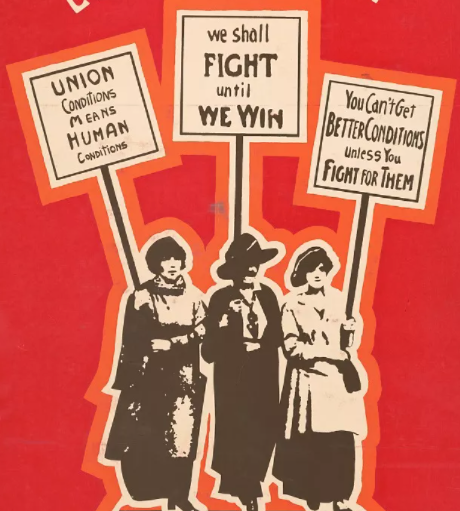
Did you know that International Women’s Day was started in 1910 by a Ukrainian-born woman named Theresa Malkiel? She was a labor activist who collaborated with Clara Zetkin in Europe and Helen Todd in the U.S. and thousands of other female laborers around the world. They marched to demand voting rights and better pay for women.
More recently, what we’ve done to International Women’s Day and Women’s History Month is change it from a collective movement for equal rights to a spotlight on individual female achievements. That shift does two things:
1) It makes many women feel like they are supposed to achieve great, heroic things on their own
2) It diminishes the need for men and women to work collectively for workplaces that are truly equal and inclusive.
The interesting thing about Theresa Malkiel, Clara Zetkin, and Helen Todd, is that they all admitted that it wasn’t until women were workers in the formal economy that they saw themselves as worthy of rights.
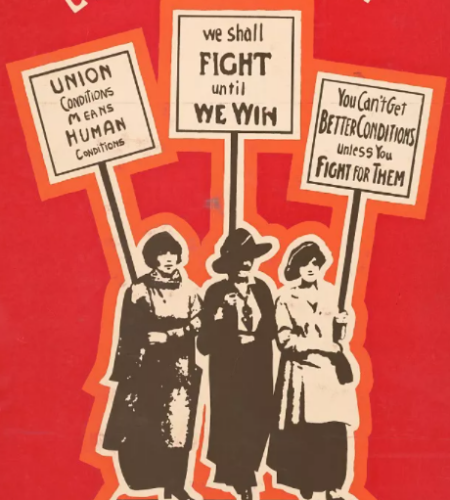
As women, they didn’t see their worth or value.
In the spirit of collective action, I asked my friends in four different countries,
What does it mean to be a woman in the workforce?
One friend reminded me:
“Women, especially women of color, have ALWAYS worked. It’s often unpaid, often unrecognized labor, while their counterparts’ efforts are considered formal work and included in the formal economy.”
Yes!
This is why the collective is so powerful. She gave voice to an essential aspect that I had missed. Women have always worked, and yet that work is perennially undervalued.
I asked more wise friends to chime in.
Being a woman in the workforce means…
They also gave voice to what they love about working in the formal economy:
Their responses resonated with me and gave me a feeling of connection that I’ve been craving for, well, two years now!
What we’re going for in life is not just outer achievement, but inner strength and a state of peace and wellbeing. Helen Todd spoke about the goal of equal rights for women as “Bread and Roses” –not just ALL the work, but ALL the pleasure, too!
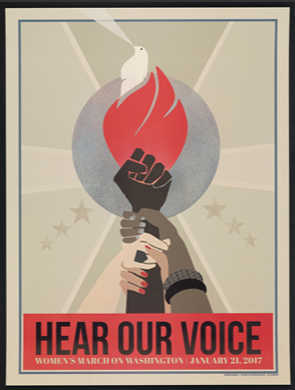
International Women’s Day and Women’s History Month is about our collective courage, not individual heroism.
This month, every month, it’s not just about showing up and honoring a few individual heroes, it’s about HOW we show up each day for ourselves and for each other.
It’s about how powerful we are when we see ourselves as having value. It’s about linking arms together to get sh** done at home, in the formal workplace, and everywhere in between until we finally close the gap in gender equity.
Love,
Susie
***
image credits:
top: Internationalwomensday.com image of 2022 theme #breakthebias
middle: Chicago labor organizing poster. Image courtesy Library of Congress, https://www.loc.gov/resource/ds.13465/
bottom: poster from women’s march in 2017 from womenshistorymonth.gov
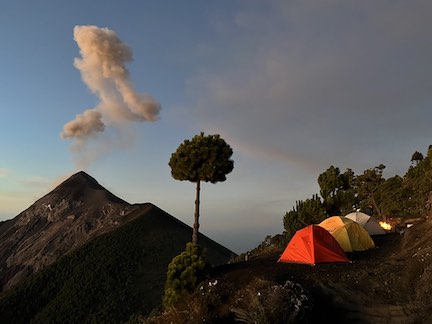
Our son Cole is alone on a gap year in Guatemala. Recently, we visited him and hiked a volcano. The plan was to climb up dormant Volcán Acatenango, spend the night, and watch active Volcán Fuego’s strombolian eruptions in the dark.

Before the trip, the anticipation of all the unknowns kept me up at night. Fear flared and ruptured my sleep. Will we make it? What if I did all that work to heal only to die on a volcano?
I’ve learned that Fear never goes away, no matter how skilled I get at facing it. I am mostly healthy, feeling great, but my mind is convinced that another shoe is going to drop at any moment.
The Brave over Perfect move is to recognize the difference between Fear and Fact, and move forward anyway.
Part I
The start is steep and in some ways, the toughest portion. This is not how most hikes are, but it is, in my experience, how most of life’s challenges are. Lukas, our wonderful guide from Old Town Outfitters, reminds us to go slow and take many breaks.

We walk uphill in deep volcanic sand. I take one step forward then slide back half a step. Cole is hiking in jeans and basketball shoes, carrying the tent and our water, so he slides even further back than I do. We laugh, but we’re out of breath. It hits me that we are hiking through corn fields. This breathtakingly-steep ascent is a local farmer’s daily commute.
While in Guatemala, Cole is living with a coffee farmer, Eduardo, and his family. To reach his coffee fields, Eduardo climbs straight up for over an hour every day. I look around me in awe.
Part II
Soon, farms give way to jungle in a cloud forest dominated by giant Canak trees. We stand inside one of the older trunks in wonder.
The higher we climb, the closer the clouds. It’s the dry season, but it’s raining. My mood falls; I’m worried that it’s too cloudy to see Fuego. Kurt and Cole are not worried; they are happily talking about Formula 1 racing.
Then the clouds lift, and there is Fuego. On cue, it erupts. All thoughts empty from my mind as rocks roar out the top and rumble down to the valley. It’s more stunning than scary. At least it is while we stand over here, on a totally different mountain. I stare in awe.
click here to see short volcanoerupts movie.
At basecamp, it’s time to set up our tent. Lukas asks, “Do you want to see the sunset from the summit? Another hour, maybe two, of hiking?”
We are not at the summit yet? I’ll skip it; my bed is right here and it’s warm. No. I have to stand back up.
The “trail” is more like a vertical black beach. I think about the indigenous girls who live nearby, who go to the MAIA impact school that I have been connected to for some time. They have a steep climb ahead of them. The girls entering 7th grade have not been to school since 4th grade because of Covid. And the number of families in extreme poverty has doubled. Thinking of their perseverance helps me to get back on my feet.
Part III
I remind myself to focus on five, breaking up the ascent into small, five-minute chunks. We’re at about 13,000 feet. The going is slow, but I feel good. We’ve come so far.
At the top, the sun is a fiery red rinse as it sets over all of Guatemala and the Pacific ocean. The clouds are no longer a threat to the view; they are the view.
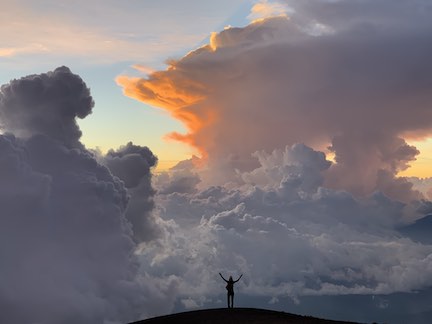
I worked through a lot of stuff on the way up this volcano. I am not my fear, my frustration, or my doubt. They are clouds, moving by. I just watch in wonder.
We walk down by the light of our dimming headlamps and bright stars. Cole gives up on walking and sleds down on his shoes.
All night, we listen to Fuego’s explosions and don’t sleep much. We wake early to watch the sunrise over Volcán Agua. After a cup of coffee, I am feeling full of gratitude and wonder.

We head straight to the village where Cole’s host family lives. We gather with Eduardo and Francisca, their children and grandchildren for a Thanksgiving meal of traditional Pepián. Cole translates. I am moved to tears by how this country that has been important to me is now important to him. And by how many amazing mothers Cole has now 😉
There isn’t a tidy moral or metaphor at the end of this story. It’s rough out there right now with a warming environment, the Omicron variant, and a widening gap between rich and poor. But this planet is so beautiful and there are incredible people fighting hard to make things better. If life is a string of challenges, I choose to face them by putting myself in the path of awe and wonder.
This holiday season, may you find a little awe and wonder too.
Love,
Susie
***

Sometimes the world feels like a big ball of poop and I am the dung beetle, pushing it uphill and backwards, blind to where I am going. Do you know what I mean?
This act of staying alive is hard work and yet the hill keeps getting steeper with the Delta variant raging, wildfires multiplying, and humans screaming at each other over wearing masks. There is no immediate cure, and the challenge continues. I felt overwhelmed, depleted, and worn down by it all. Then my friend and I stumbled upon a few dung beetles on the trail.
― Mary Oliver, Red Bird
I didn’t know we had dung beetles in Colorado. But there they were, hard at work, pushing dung balls three times their size, uphill. Watch the video to see how they do it. It’s incredible. They steer their manure pile upside down and backwards, using only their hind legs.
It’s not easy being a dung beetle. I mean, How do they roll the balls of dung in a straight line when their heads are down?
click here to see short movie I took of a dungbeetle
I did a little reading. Studies show that dung beetles use the path of the sun and the stars to guide them. When researchers placed tiny cardboard hats on the beetles that blocked their views of the stars, the scientists observed that the beetles just “rolled around and around and around in circles.” Once the hats were off, the beetles moved their balls of dung on a straight course. But how? Sometimes, the dung beetles climb atop their globes of manure, raise their little arms to the sky, and do what looks like a dance.
Scientists have since discovered that when the beetles do this dance, they are taking a mental snapshot of the sky. They use this snapshot to navigate in a straight line when they go back to work, heads down.
It turns out that one mental picture of the night sky is all they need to navigate a clear path. Until the way forward is no longer obvious. Then they climb back atop the dung, do another dance, and take a fresh picture.
If tiny, tiny brains can solve complex problems, so can we.
If we are the dung beetles, feeling the full weight of this planet, it’s easy to get lost and spin in circles. It’s time to climb above the sh** and get a new picture of the way forward.
To gain perspective, take stock of where you are. See clearly what’s around you. Then plot your course. You may end up changing directions based on where you are now. A straight path doesn’t mean no jogs or tacks; it means that on average, looking back, it was a straight course.
Maybe the dung beetles are giving us the recipe for how to get through a personal crisis, plus another day worrying about Afghanistan, Haiti, the next hurricane, or the next variant.
Discipline and dream. Head down and eyes to the sky. They are not opposites. They are the key ingredients to turning sh** into Shinola. And for moving forward in uncertainty. Do the work, yes, but stay loose, open to change. Continually trust that there is more to see than this massive ball of manure. Go somewhere with a little height and a clear view of the skies, and dance.
Love,
Susie
***
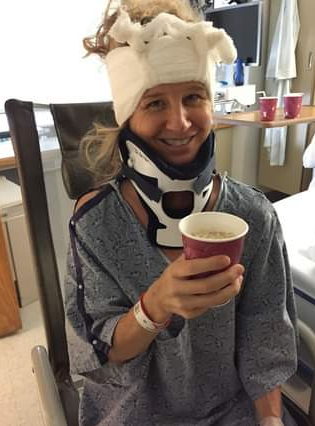
This month marks the 5 year anniversary of my major surgeries! Can you believe it?! I don’t take this life for granted. But every year since then I’ve had some kind of recurrence or treatment. This summer is the first one since 2016 that I haven’t had to go back under the knife (knock on wood)! I celebrated by immersing myself fully in the natural world, foraging for mushrooms, visiting with family and friends. I haven’t written in months because I’ve been trying to squeeze the most out of summer and light!
Five years ago, I was focused on surviving. Multiple recurrences later, being a “three time survivor”, as they say, my focus is on health and wellness in the throws of uncertainty. It seems powerfully relevant for all of us right now. But where is the heart of my work?
“It may be that when we no longer know what to do, we have come to our real work, and that when we no longer know which way to go, we have begun our real journey. The mind that is not baffled is not employed. The impeded stream is the one that sings.”–Wendell Berry
Should I focus my coaching work on young people or on school leaders? I asked a spiritual advisor/friend. We sat in a room full of crystals, candles, and white sheepskin rugs. She guided me on a meditation deep into my unconscious. I told her I saw a cave, and a green pool of water, and light coming from the water. I must have described what I saw for ten minutes, before she stopped me.
“I don’t usually interrupt people, but I can’t take it anymore. It’s so obvious.”
“Excuse me?”
“Work with young people!”
“Is that what the green pool of water is about?”
“Who knows?! Your experiences and your skills are with mentoring young people. They need you. Go to them.”
We both laughed out loud. Sometimes, the spiritual leader needs to state the facts, not interpret the cave. And often, we can’t see our own strengths. We need others to help us see the obvious.
As for my work in wellness? Currently, I’m in an intensive workshop designed to regulate our nervous systems, so that we can boost our immune systems and better handle uncertainty.
I am learning fascinating things about the vagus nerve and how to condition it. This nerve superhighway begins in our brain stem and wraps around our lungs, heart, and every major organ. Our vagus nerve communicates to the brain everything about our internal world. It helps us with calmness, relaxation, and digestion.
“I have a lot of faith and a lot of fear a lot of the time.” –Anne Lamott
Through specially-filtered music and restorative yoga with Patricia Gipple, we’re training our nervous system to unstick itself from being perpetually agitated into a place of being able to handle anything.
It’s powerful work. I can already feel a shift in my mood from “I am exhausted and scared” to “I don’t know how this is going to work out, but I know it’s going to work out.”
I’m excited to bring this work to the young people I coach, and to you, through my writing.
In August, the work we all need to do is pay attention to abundance; notice the peaches and ripening apples. Notice the roadsides full of milkweed and sunflowers. Notice each other. Tonight, notice the light the rare “Blue” moon shines down on us.
Love,
Susie

Dear Cole,
I’m writing you from our front porch, on the eve of your high school graduation.
Life is not easy. You know that. You have lived that. It’s not about building a life that is easy–without pain or confusion–it’s about living life fully, completely, and compassionately. I know you can do that because you already have.
You have backbone in you now that will never leave you. You just have to talk to your courage, ask it for a clue as to what the next best step might be.
Talk to me, too, wherever I may be. As Anne Sexton, the poet, said to her daughter, “Talk to your heart. I am in it.”
I’ve lived a good life, a life full of adventure, and love. You can, too. Go for it! Risk discomfort for meaningful experience.
Do you remember how scary it was to disassemble your car and how fulfilling it was to put it back together, figuring it out as you went along? It’s not a bad analogy for how to make it through tough times.
Or do you remember the story about the time I was learning to surf and was embarrassed by how terrible I was? And how I didn’t want to tell anyone I was surfing until I got really good? And how, at a party with interesting, cool people, I went to shake a fascinating woman’s hand and just as I did, sea water streamed out my nose? I apologized and tried to explain that I had just been surfing, but not very well, and that I was sorry, and excuse me while I went to get a tissue. Do you know what the fascinating woman replied?
“When I see the surfers as I drive home from work at sunset, I think, what a beautiful painting! But you–you are not looking at the painting, you are in the painting. Don’t ever apologize for being in the painting!”
Aim for a life where you are in the painting–out in the world, trying things, throwing your whole, messy self into it, instead of waiting for mastery to begin.
There is a Taoist story of an old farmer and his son. Maybe you know it.
One day the farmer’s horse ran away.
“What bad luck!” His neighbors said.
“We’ll see,” replied the farmer.
The next day, the horse returned with three wild horses.
“How wonderful!” said the neighbors.
“We’ll see,” said the farmer.
Then the farmer’s son tried to ride one of the untamed horses, was thrown, and broke his leg.
“How terrible!” said the neighbors as they brought food and flowers.
“We’ll see,” said the farmer.
The next week, military officials came to the village to draft young men to the army. They saw that the son’s leg was broken, and passed him by. When his neighbors came around once again to say “What good luck!”
“We’ll see,” the farmer said.
Only time can tell the whole story. We never know whether something is good or bad luck when we are in a situation.
Trust that every time you’ve been challenged, you’ve learned something. When you broke your foot, you learned to beat Papa at chess. When I was diagnosed, you learned how to be a good friend to Joako. When Covid cancelled in-person classes, you learned to replace the clutch in your car. It doesn’t help to divide life into good and bad events, because we can’t see the future.
Experience life as it is and don’t fight the moments. Being an adult doesn’t just happen because you turn 18 or graduate. Adulthood is a process of becoming. You have to earn it by facing difficult times with openness and curiosity, not just fear.
At dinner table arguments with your sister, I see how often you are right. I also see how important it is for you to be right. Remember, don’t take yourself, or the world, too seriously. Go lightly. Practice being kind rather than right. It feels good to “win” an argument, but it feels better to boost others up and see them discover what is right for them.
Recently you spoke about your need to let go of trying to know everything. You said that you feel more comfortable in uncertainty now. The way you put it was, “it’s okay to wonder.” I love that. It reminds me of something the brilliant Toni Morrison said, “Meet the unfamiliar with unflinching friendliness.”
You are perfect now, you were perfect when you were born. It is okay to wonder. You don’t need to know everything, or to be right all the time, to earn love.
Papa and I love you unconditionally, Cole. Go into the world knowing that, and watch the way the world responds with love.
xox mama
more published letters: